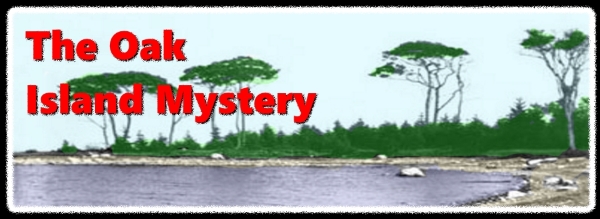

Aar, Jim lad, what be buried on Oak Island? Prepare to have your timbers shivered and your swash buckled as we look at the mystery of what may lie buried beneath Oak Island off Nova Scotia. People have been diligently searching the island for buried treasure for at least one hundred and fifty years. The problem is, no-one is quite certain what it is they have been looking for. Pirate treasure? Aztec (or Roman, or Egyptian) treasure? The Ark of the Covenant? Lost manuscripts written by Francis Bacon proving that he is the author of works attributed to Shakespeare? An ancient alien mind control device? All these things have been suggested, though there is another possibility that is less often discussed: that this is nothing but a giant boondoggle and that absolutely nothing at all is buried on Oak Island.
Lots of websites, several books and a reality (I use the term loosely) television series have all attempted to address the Oak Island mystery and a number of commercial ventures have attempted to raise money to excavate there. The problem is, most have used doubtful or just plain wrong information in their efforts to justify what they have done. Let’s see if we can cut through the nonsense to find out whether there really is a mystery buried off the coast of Nova Scotia.

Oak Island is one of a large number of small islands in Mahone Bay in Nova Scotia, Canada, around twenty-five miles west of the city of Dartmouth. The island is around one mile long and half a mile wide. It’s now known as Oak Island because of the large numbers of oak trees which once grew there (though very few remain today) but it seems to have been originally named Gloucester Island by the first English settlers. This area was originally the home of the Mi’kmaq tribe but Europeans have been visiting since the 14th Century. The first permanent white settlers in the area were French who arrived around 1750. By 1763 Britain had wrested control of Canada from the French and British settlers moved in. The islands in Mahone Bay were used by these early settlers for grazing cattle and sheep – this saved building fences and kept the animals safe from the predators found on the mainland.
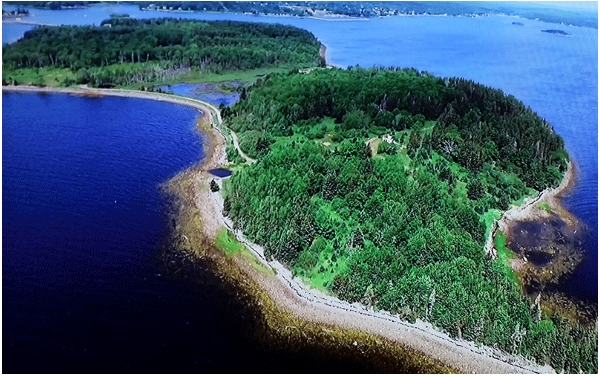
Normally, in the Just the Facts section I provide only the known facts about a particular mystery. That’s more difficult here for reasons which I will explain a little later so, what I am going to do is to divide this section into two parts: the period from 1795 – 1860 and the period from 1860 to the present. The description of the first period is what you will find in a number of books, articles and websites about the Oak Island mystery.
1795 – 1860
Sometime in 1795 (some accounts say June, most favour October) a local teenager called Dan McGinnis rowed a boat out to Oak Island to look around. The island had a sinister reputation in the local area with reports of ghostly lights seen at night and a large phantom black dog. McGinnis was curious and wanted to see what he could find there. What he discovered was a cleared area in the centre of the island where a block and tackle were suspended from the limb of an oak tree over a circular depression 12 – 14 feet in diameter. McGinnis quickly surmised that something heavy enough to require the use of lifting gear must have been buried beneath the tree limb. There were a number of local rumours of buried pirate treasure, so McGinnis returned a short time later with two teenage friends, Anthony Vaughan and John Smith.
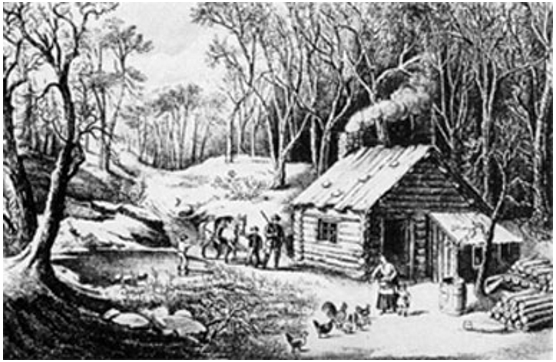
Equipped with shovels and picks the boys began digging and quickly discovered a thirteen foot diameter shaft sunk into the hard limestone which forms Oak Island. The digging was easy, suggesting that someone had dug the hole out and then re-filled it with spoil. Around two feet under the surface they discovered a layer of flagstones. These were not native to Oak Island and later investigation suggested that they originated at Gold River, around two miles north-east of Oak Island. They continued digging and at a depth of ten feet came to a platform made of sturdy oak logs which had been jammed into the sides of the pit. The logs were decayed, suggesting that they had been buried for some time, and the boys removed them and continued to dig. As they were digging, they could clearly see the marks of picks on the walls of the shaft, confirming that this was a man-made shaft and not a natural sink hole (of which there are many in the area). At a depth of twenty feet they came to a second oak platform, which they also removed. When at thirty feet they arrived at a third oak platform, they decided that they had made as much progress as they could unassisted and returned to the mainland.
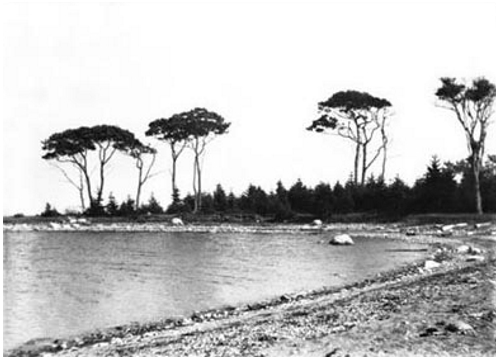
Oak Island in 1931
The local farmers were uninterested in further digging and no more excavation was done on the site for eight years. John Smith bought a parcel of land on the island which included the shaft the boys had partially excavated and then built himself a cottage on Oak Island and lived there with his family. Dan McGinnis also spent time on the island, though he did not have a permanent home there.
Sometime around 1802 a new character appears in the story: Simeon Lynds. There are several versions of how Lynds became involved with the excavations on Oak Island. Some accounts have him as a relative of either Vaughan or Smith, or a local doctor who attended the birth of one of Smith’s children or perhaps just a local businessman who heard the story of what had become known as the “Oak Island Money Pit”. However he became involved, Lynds organized a consortium of local businessmen in the nearby town of Onslow to fund further excavation and to share whatever was uncovered. The Onslow Company sent workmen to Oak Island in 1803 and they further excavated the shaft discovered by the three boys.
As they dug deeper into the shaft, they encountered more oak platforms set at ten foot intervals. However, these lower wooden platforms were covered by layers of charcoal and in some cases by a strange mass of fiberous material which was later identified as the outer husks of coconuts. On the platform at a depth of ninety feet they found a large stone with a strange inscription on it. They removed the stone from the shaft and continued digging. At approximately ninety-eight feet they reached what they believed might be a wooden chest. However, darkness was falling and it was decided to continue digging the next morning. When the men returned next day, the shaft was filled with water to a level thirty feet below the surface. No matter how much water they removed, they were unable to lower the level of water in the shaft, suggesting that it was somehow connected to the sea.
In 1804 the Onslow Company team returned to Oak Island. This time, they dug a new shaft next to the original money pit. They excavated without difficulty to a depth of one hundred and fourteen feet and then tried to tunnel through in the direction of the Money Pit, hoping to dig through underneath the supposed treasure chest. As soon as they broke through, water flooded the new shaft to the same level as the original and no amount of pumping or bailing was able to lower the level. Defeated, the Onslow Company abandoned the money pit. Smith continued to live on the island and at some point filled in both shafts. The inscribed stone from the money pit was first used to form part of the fireplace in Smith’s cottage but was later taken to Halifax and put on public display in a bookbinders shop there.
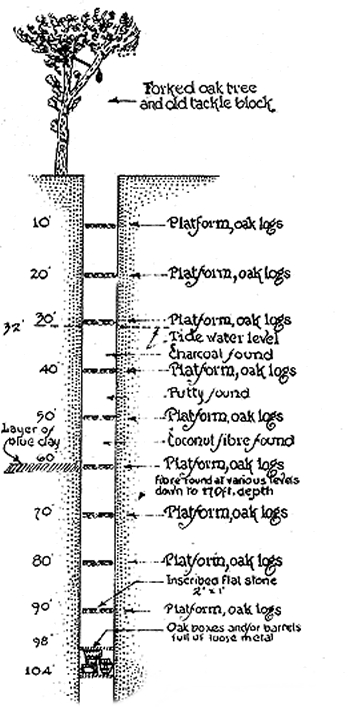
A much later illustration which claims to show what was found in the money pit between 1795 and 1804
In 1849 John Pitbladdo and Charles D. Archibald applied for a license to hunt for treasure on Oak Island and formed the Truro Company. At some point this group sent an expedition to the island to dig under the control of foreman W. Graham. Dan McGinnis was dead by this time but one of the two other people who originally found the money pit showed where the now filled-in shaft was. Digging commenced but, when they reached a depth of eighty feet, the shaft once again flooded. Pitbladdo had a platform built in the shaft just above the level of the water (around thirty feet below the surface) and from there an auger was used to drill down to the base of the shaft. There, it was claimed, they found a layer of wood below which was “five inches of metal in pieces”, then more wood before finding 22 inches of additional loose metal. The story of wood containing loose metal irresistibly suggested oak chests containing treasure but because of the flooding it was not possible to excavate further.
The Truro Company sent at least one more expedition to Oak Island who dug yet another shaft next to the money pit. They reached a depth of one hundred feet and then seawater flooded the shaft. It was noticed that the level of water in the shafts rose and fell with the tide, suggesting a direct connection to the sea. Exploration of Smith’s Cove nearby revealed that what had at first seemed to be a natural beach was actually man-made, with layers of coconut husks and eel grass covering flat stones which appeared to cover the entrance to a network of drains. It was surmised that this was where seawater was entering the shafts and the team attempted to build a cofferdam to hold back the sea from the small bay. Unfortunately, a storm broke up the cofferdam before they could test this theory and the Truro Company ran out of money which prevented any further attempts at digging on Oak Island. The discovery of this supposed man-made beach and drains raised for the first time the idea that the original builders of the pit might have incorporated cunning booby traps which would cause the pit to flood if it was excavated.

Before I go on to talk about the later period in the history of Oak Island, I want to talk some more about this story of the early period which you will find reported as established facts in many accounts of this mystery. First, the story contains some very obvious internal logical contradictions. The block and tackle suspended over the filled-in shaft is one of those. You might as well leave a sign saying “Hey! You know that depression in the ground that you probably didn’t notice? Well, guess what? Something is buried there!” Are we to believe that someone spent days, weeks or even months digging a massive shaft in which to hide something and then didn’t take the additional five minutes to remove the block and tackle which so clearly pointed to it? That doesn’t sound very likely to me. And what about the stone with the inscriptions? Why on earth would you leave something like that ninety feet under the earth? To make sure that someone trying to uncover what you had buried didn’t give up?
And what about the initial digging out of the shaft? The story as generally told makes this sound like a jolly jape undertaken by three enthusiastic teenagers. But to excavate a hole 13 feet wide by thirty feet deep means removing around 115m3 of earth, weighing somewhere in the region of 175 metric tons. For the first five or six feet, that isn’t too difficult because you can simply throw the excavated earth to the surface. After that, you have to build ladders and platforms to bring the earth to the surface. Are we to believe that three teenaged lads did this on nothing more than a whim? Just how long did it take? And what about the supposed filling in of both pits by Smith sometime after 1804? This would require moving more than 1,000 tons of earth by hand (there were no mechanical excavators small enough to be transported to Oak Island in the early 1800s). This would represent a massive amount of work. Why not just cover over the top of the shafts? I suspect that descriptions of the early excavations were invented or exaggerated for reasons explained below, and that the story of Smith filling in the shafts was also invented to account for the lack of two very deep shafts when later treasure hunters cam to Oak Island.

The Halifax Gazette (first published in 1752) was just one of the newspapers published in Nova Scotia during this period, but like all the rest, it didn’t carry any stories about the Onslow Company or Oak Island.
All these things make me doubt the story of the early period, but it gets worse. No-one has been able to find any contemporaneous reports of either the initial find or the attempt by the Onslow Company to excavate the shaft. This was a small community and there were a number of local newspapers which reported on the minutiae of day-to-day life in this area in the early 1800s, but there is no report of something as newsworthy as a dig for buried treasure by a consortium of up to thirty local businessmen and the labourers they must have hired. Nor has anyone managed to find any mention of the Onslow Company or its search for buried treasure in any contemporary letter, journal or diary. Something is very wrong here. And when researcher Richard E. Joltes (you’ll find a link to his website at the end of this article) went back to primary source material, he found that the only Dan McGinnis living in the area at the relevant time was a man who would have been in his late thirties in 1795 – so much for the romantic story of teenagers finding the money pit! The only documentary evidence backing up the story of treasure hunting on Oak Island up to 1860 is the application for a license by Mr Pitbladdo in 1849 and a single diary entry by a tourist who visited the abandoned workings in 1857. So, where does all this information on the early history of treasure hunting on Oak Island come from? It all originates in 1860/1861 when yet another new company, the Oak Island Association, publicized the story through a prospectus and newspaper interviews intended to attract investors to the new venture.
1860 – Present
The Oak Island Association was founded in 1860 and raised money to fund several expeditions to Oak Island between 1861 and 1864. All had similar results: digging in what was believed to be the original money pit achieved a depth of 112 feet without finding anything of interest before it resulted in flooding which could not be alleviated even by use of a steam pump. Excavation of adjacent shafts proceeded without difficulty, but when any attempt was made to dig through to the money pit, these too flooded. The Oak Island Association was wound up in 1864. Soon after, the Oak Island Contract Company was formed, but failed to raise sufficient funds to undertake a single expedition to the island. Then along came the Oak Island Eldorado Company which did manage to fund some digging on the island, with dismally familiar results. New shafts were dug, but any attempt to connect with the money pit resulted in flooding. By 1867 this company too had ended digging having discovered absolutely nothing. However, this attempt on the money pit did produce one of the most important pieces of documentary evidence about this mystery. In 1866 an engineer called John Brown was employed to take part in the digging on Oak Island and in January 1867 he wrote a long letter to the principals of the Oak Island Eldorado Company. This long, handwritten letter was discovered by Paul Wroclawski, a Nova Scotia based researcher and retired engineer.
In part, the letter reads:
“I should be doing W Graham great injustice did I not believe that he personally is convinced, that the borings of 1851 actually penetrated the treasure; but it is the easiest thing in the world for the most honest man to be deceived, especially in connection with borings having for their purpose the discovery of immense amounts of treasure; one’s imagination is so readily excited by the supposed proximity of wealth, that we are not in a position to discuss and examine evidence which under other circumstances would not be for a moment entertained.
Doubtless Messrs Graham & Co passed through wood, but when the wood was brought up in the augur, why did the coin not also come up, from mere curiosity, I often at a depth of 150 feet threw money into the hole, of course it came up in the augur and I for one should not be in the least afraid to throw any amount in, and to bring up every piece. If the treasure existed in layers as was supposed, confined in a chest or even in bags, it is my opinion that provided the augur once entered it would be impossible for some of the contents not to have been brought to the surface.
I might also mention that during my operations I frequently passed small layers of gravel, at which times the grate of the augur so greatly resembled the sound I should fancy would emanate from gold or silver coin, that it was difficult to undeceive myself until the augur was withdrawn.”
Extract from http://www.criticalenquiry.org/oakisland/johnbrown.shtml
John Brown went on to point out that the money pit itself could not be man-made but must be a natural sink-hole because it did not descend vertically but at an angle, something that is very difficult to achieve with a man-made shaft. He also concluded that the flood tunnel (or tunnels) which caused the shafts to fill with seawater were also natural tunnels and not man-made. That seems pretty definitive: this is not a man-made shaft filled with treasure, it’s a sinkhole filled with gravel, wood and other debris which has been washed in to it over the years. No wonder that the Oak Island Eldorado Company wound up operations in 1867, soon after receipt of this letter.
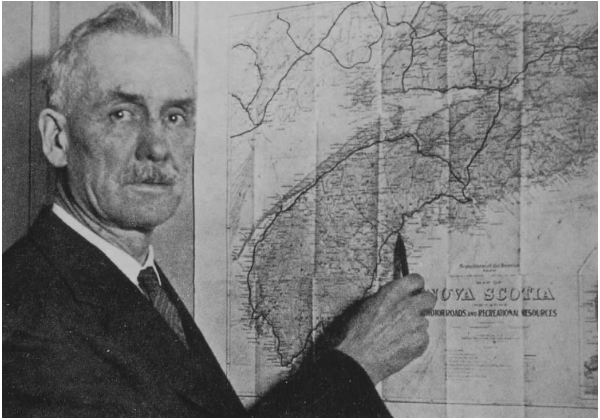
Frederick Leander Blair
And that, you might reasonably imagine, would be the end of the Oak Island story. But you’d be mistaken. It seems that the lure of buried treasure exerts a greater pull on the imagination than any rational analysis. In 1893 a man called Frederick Leander Blair purchased the treasure hunting rights for Oak Island, formed the Oak Island Treasure Company and issued a prospectus in which it was noted:
“It can be proven:
- That a shaft about 13 feet in diameter and 100 feet deep was sunk on Oak Island in Mahone Bay, Nova Scotia, before the memory of any now living.
- That this shaft was connected by an underground tunnel with the open ocean, about 365 feet distant.
- That at the bottom of this shaft were placed large wooden boxes in which were precious metals and jewels.
- That it is reasonably certain the treasure is large, because so great trouble would never have been taken to conceal any small sum.
- That it is now entirely feasible to thoroughly explore this shaft and recover the treasure still located therein.”
Now, if you have been keeping up with the story so far, you’ll note that none of these things is actually proven and evidence such as the John Brown letter suggest that most of this had actually been thoroughly disproven by 1893.
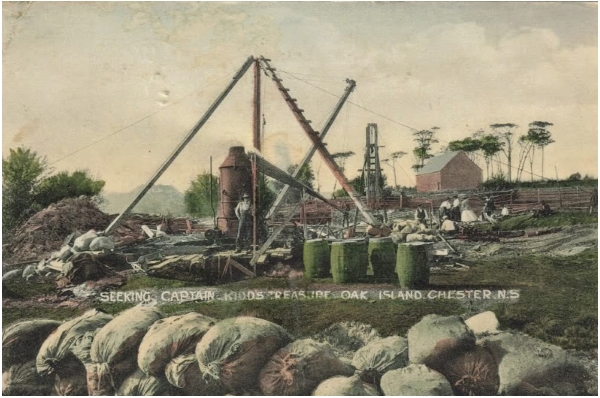
Commemorative postcard issued to mark the Oak Island Treasure Company dig on Oak Island.
This minor issue didn’t deter prospective investors and by 1896 Blair had raised the $60,000 required to mount a new series of expeditions to Oak Island. One of the things that encouraged potential investors was that the Prospectus for the Oak Island Treasure Company also included the sensational news that the symbols on the inscribed stone which had been recovered at the ninety foot level in 1803 had finally been deciphered!
“One of the experts gave his reading of the inscription as follows: “Ten feet below are two million pounds buried” We give this statement for what it is worth, but by no means claim that this is the correct interpretation. Apart from this, however, the fact remains that the history and description of the stone as above has never been disputed.”
No information was given as to which expert had provided this information and the symbols from the stone were not reproduced in the prospectus. The Oak Island Treasure Company organized expeditions to the island in 1896/97 but you will be unsurprised to hear that all these achieved was the digging of even more shafts which inevitably flooded beyond the capacity of available pumps. By now the area around the original money pit was honeycombed with additional shafts and had become too dangerous even to walk on, so some of the additional shafts excavated in 1897 were dug up to 100 feet from the original money pit. In desperation, the Oak Island Treasure Company resorted to the use of dynamite, both to speed excavation and in the hope that this would block the inflow of water which was presumed to be coming from the drains in Smith’s Cove. In 1900 the company accepted defeat and was wound up. However, before they left Oak Island they did perform one useful task – dye was dropped into one of the shafts and, as expected, traces of this dye were seen in Smith’s Cove. However, dye was also seen in the adjacent South Shore Cove, which strongly suggested that blocking the drains in Smith’s Cove would not itself be sufficient to stop seawater entering the shafts.
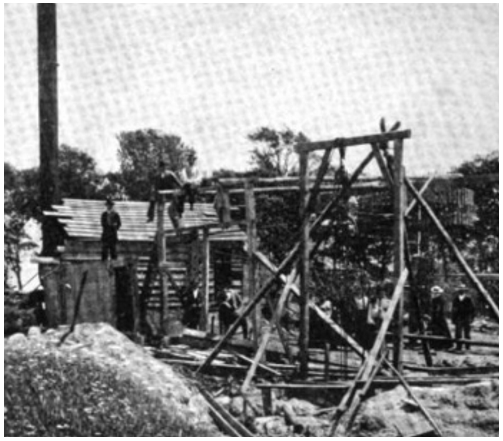
Oak Island diggings, 1899
In 1909 Frederick Blair joined forces with an engineer, Captain Henry L. Bowdoin, to form the Old Gold Salvage and Wrecking Company which issued a prospectus claiming that the reward for investors might be up to $10,000,000. Two expeditions were mounted in 1909 and 1910 which dug several new shafts (all of which flooded) and tried (unsuccessfully) to block the ingress of seawater from Smith’s Cove. A number of test bores were undertaken in the supposed vicinity of the original money pit (there were by now so many shafts in the area that it was difficult to be sure which was the original) hoping to confirm the findings of earlier expeditions.
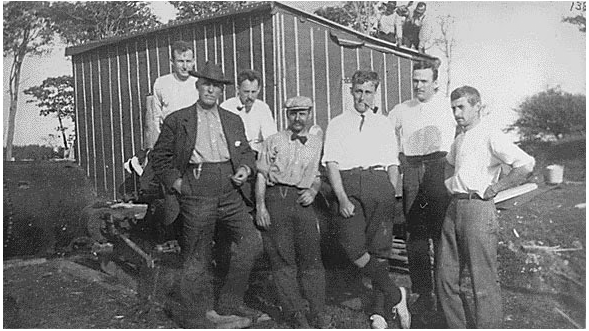
Work crew on Oak Island in 1909. The young gentleman with the pipe, third from the right, is twenty-seven year old Franklin Delano Roosevelt who entered politics the following year and later became President of the USA. Roosevelt maintained a lifelong interest in Oak Island.
Nothing at all was found and the new partnership broke up in some acrimony with Bowdoin publishing an angry article in Colliers Magazine in 1911 titled “Solving the mystery of Oak Island.” In this he concluded that “My experience proved to me that there is not, and never was, a buried treasure on Oak Island. The Mystery is solved.”
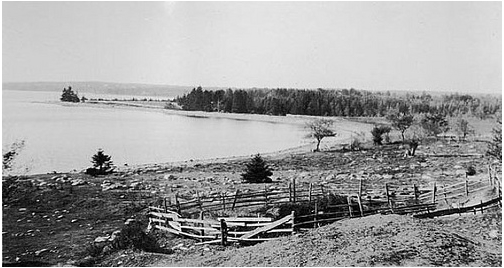
Oak Island in 1931
Undeterred, several individuals searched for the Oak Island treasure in the 1920s, but nothing of note was found. In 1931, 1932 and 1938 major expeditions were mounted, all of which involved Blair as he still owned the treasure hunting licence for Oak Island. None of them achieved anything except further hiding the location of the money pit by digging additional shafts – when Blair arrived on the island he was able to inform one expedition that they were digging in completely the wrong place.
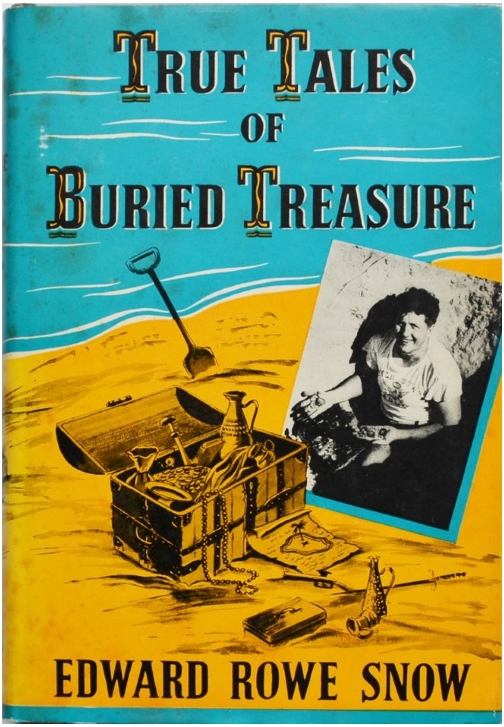
During World War Two the ownership of Oak Island changed hands and when in 1955 a Texan oil millionaire named George Greene decided to search for the treasure, he negotiated with the new owner, William Chappell. One of the factors encouraging Greene was the publication in 1949 of a book by Edward Rowe Snow, True Tales of Buried Treasure. This book provided a slightly different deciphered version of the message inscribed on the stone recovered at ninety feet down the money pit in 1804. This, it now claimed, read:
Forty feet below two million pounds are buried.
In addition to the obvious change from ten to forty feet from the original solution given in the Oak Island Treasure Prospectus, the syntax here is also slightly different. But for the first time, Snow’s book also included what was claimed to be an illustration of the symbols from the original stone. However, like so many aspects of this story, this doesn’t stand up to detailed scrutiny. Quite apart from the obvious absurdity of someone hiding treasure down a deep shaft and then placing a message which would simply encourage excavators to dig deeper, the provenance of the alleged inscription is very doubtful. The stone which was recovered in 1803 was claimed first to have been used as part of John Smith’s fireplace before being placed on display in Creighton’s Book Bindery in Halifax. At some point the stone was used as a beating stone for book binding until the inscription was eventually completely worn away. By around 1912, it seems to have disappeared completely. No-one ever seems to have tried to photograph or make a rubbing of the inscription.
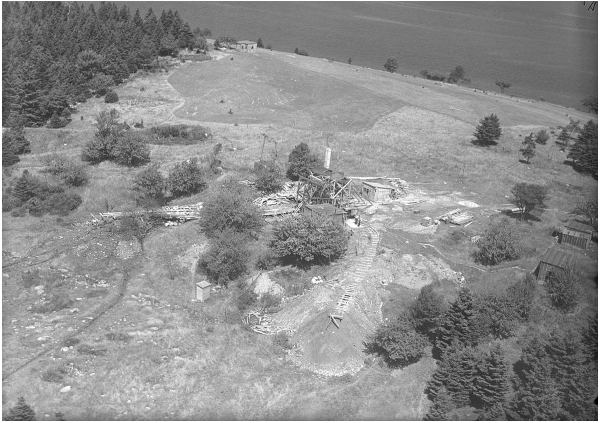
Ariel view of part of the Oak Island diggings, 1955
Edward Snow claimed to have received details of the inscription from Reverend A.T. Kempton of Cambridge, Massachusetts. Reverend Kempton claimed he had received this information around forty years before when researching for a planned (but never published) book on Nova Scotia. He had written to a local minister for information on Oak Island who had in turn passed his request to a local teacher who had sent him details of the inscription and the deciphered version produced by yet another teacher. Kempton went on to explain that all these people were, by 1949, dead.
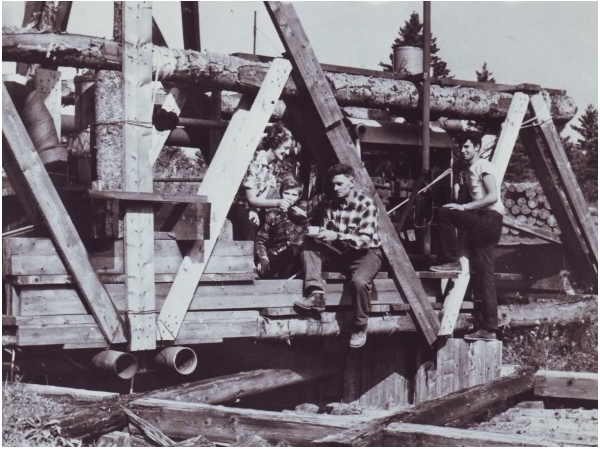
Bob Restall and family on Oak Island in the early 1960s
Despite the encouragement of the deciphered message, Greene was unable to find anything of interest on Oak Island and in 1960 a man named Bob Restall moved with his wife and children to live in a shack on the island to look for the treasure. Restall managed to find nothing new but in 1965 he, one of his sons and two other men died in a bizarre accident in one of the shafts they had dug. All drowned in the bottom of the shaft, despite their being only around three feet of water there. It was assumed that they had been rendered unconscious by some form of gas, possibly carbon monoxide from the exhaust of a nearby pump. However, this gave rise to lurid stories about Oak Island being protected by even more deadly booby traps than those which were claimed to be responsible for the flooding of shafts and to the supposed Curse of Oak Island – Two other men had been killed during previous expeditions and George Greene was murdered in 1962 (though that does not appear to have had any connection with Oak Island).
Undeterred, the next person to attempt to uncover the treasure was Bob Dunfield. Dunfield built a causeway to the mainland so that he could bring heavy plant including bulldozers on to the island. He used these to excavate tons of earth from the area of the money pit and Smith’s Cove. None of his efforts produced any significant finds other than identifying the presence of a large void space under the island in the supposed vicinity of the money pit and he abandoned his efforts sometime around 1967.
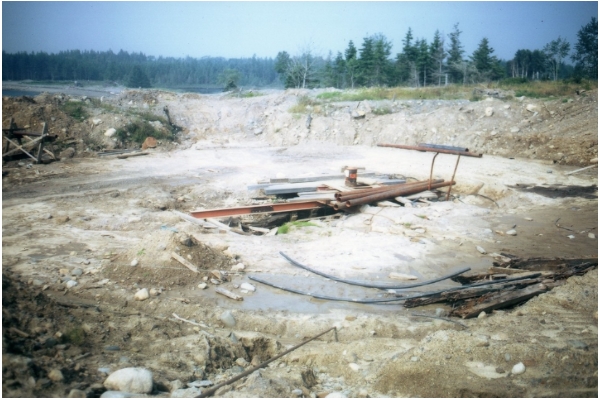
The money pit area after heavy plant had been used to remove topsoil
Then two men, Dan Blankenship and David Tobias, formed a partnership called the Triton Alliance with the specified aim of recovering the treasure of Oak Island.
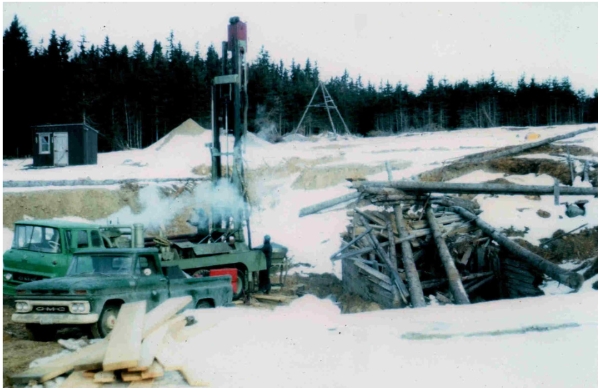
Oak Island diggings around 1968
In 1971 they succeeded in enlarging one of the shafts (by this time, no-one had any idea of where the original money pit was) and encasing the interior with a steel jacket. They then lowered a video camera down into the water in the void space beneath what was now called Borehole 10X. The images they recorded were claimed to show a severed human hand floating in the water. Later videos showed three chests, a cutlass and a dead body, slumped against the wall. Unfortunately, all these images were relayed in real time to monitors above and none were recorded. Later videos were recorded, but none of these showed anything especially clear. Below you can see an excerpt from one of these with narration by Dan Blankenship.
The Triton Alliance funded several further expeditions to Oak Island, but none recovered anything significant. Then, in 1976 Dan Blankenship narrowly escaped while diving in Borehole 10X when the shaft partially collapsed. There followed several years of legal wrangling in which rights to excavate on Oak Island were disputed. This was resolved in the mid 1980s and the Triton Alliance began seeking investors for a ten million dollar project to excavate a massive new shaft on the island – the thinking was that, if the new shaft was large enough, it wouldn’t matter that the precise location of the original money pit was no longer known. The Triton Alliance estimated that the treasure might now be worth anything from one hundred million to several billion dollars, based on nothing more than adjusting the figure from the alleged deciphered inscription for inflation. However, in 1987 the US stock market collapsed and possible sources of funding for this scheme vanished. Dan Blankenship then took up residence on Oak Island.
In January 2014 a reality television show called The Curse of Oak Island was launched. Brothers Marty and Rick Lagina from Michigan had purchased a controlling interest in Oak Island Tours which owns part of the island. The show followed their attempts to solve the mystery of Oak Island, with the assistance of Dan Blankenship (who still lives on the island) and his son Dave. The fourth season of The Curse of Oak Island premiered in November 2016.

From the left, Dan Blankenship, Marty Lagina, Rick Lagina and Craig Tester from The Curse of Oak Island
The show follows a format that will be familiar to anyone who has seen any other pseudo-science show on the History Channel (does anyone else remember when the History Channel provided shows based on, well, history?). In each episode a great deal of time is spent on speculation as to who may have buried treasure on Oak Island and what it may be (some contenders to date are pirate treasure, the original Menorah from Solomon’s temple, Knights Templar treasure, Aztec treasure, treasure left by Christopher Columbus and Roman treasure). Very little of this speculation is supported by credible evidence but I suppose that something is needed to pad out each episode because relatively little time is spent actually looking for the money pit or the treasure itself. The grand finale of series three involved a diver finally entering the chamber below Borehole 10X where the Triton Alliance video camera had supposedly showed a dead body and man-made objects such as chests. The diver found this to be a natural void space with no evidence of being artificially created and there were no chests or any other man-made objects present.
After thirty shows to date, the only new object that the Lagina brothers have located is a small copper disc that is claimed to be a Spanish dating from the mid 1600s (though there seems to be some doubt about this). The copper disc was found in an area of swamp on Oak Island and, while interesting, it doesn’t really support the idea of buried treasure. There was brief excitement when the team were presented with what appeared to be a Roman sword which had been recovered from the sea close to Oak Island but this later turned out to be a reproduction less than 100 years old. One interesting piece of work done by the team was to confirm the presence of coconut fibres in Smith’s Cove – the nearest coconut tree is more than 1,500 miles from Oak Island so this is very unlikely to be a natural occurrence.

Most of the theories that surround Oak Island are speculation on what may be buried there. Given that I’m not convinced that we have evidence that anything is buried there, I have major doubts about all of these but I’ll mention the most popular ones here.
Pirate treasure. There certainly were pirates operating off the East coast of North America. But pirates were the Hells Angels of the 15th, 16th and 17th Centuries – loose affiliations of the unemployed, the unemployable and the downright vicious with a leader whose main qualification was being even tougher and even nastier than the rest. Pirates were not noted for responsible long-term fiscal planning. They were far more likely to spend whatever booty they stole on women and ale than to bury it for recovery at some later date. The whole notion of pirates burying treasure is more of a literary device than a historical reality. This idea was popularised in Robert Louis Stephenson’s Treasure Island in 1883 but other authors such as Washington Irvine (Wolfert Webber, 1824), Edgar Allan Poe (The Gold Bug, 1843) and others had covered similar themes. The reality is that there are few confirmed instances of pirates burying anything at all. Perhaps one of the reasons that buried pirate treasure became popularly associated with Oak Island and the money pit was the presence of Captain William Kidd in the waters off Boston in the late 1600s. And Kidd was one of the few pirates who we know did bury treasure – in 1698 Kidd buried treasure on Gardiners Island, off Long Island. However, it seems likely that this was never intended as anything more than a short-term measure. Kidd was aware that he was a wanted man and his arrest appeared imminent. It seems that he may have intended to use the location of the buried treasure as a bargaining tool to ensure his release. This failed, the treasure was quickly recovered and Kidd was executed in England in 1701.
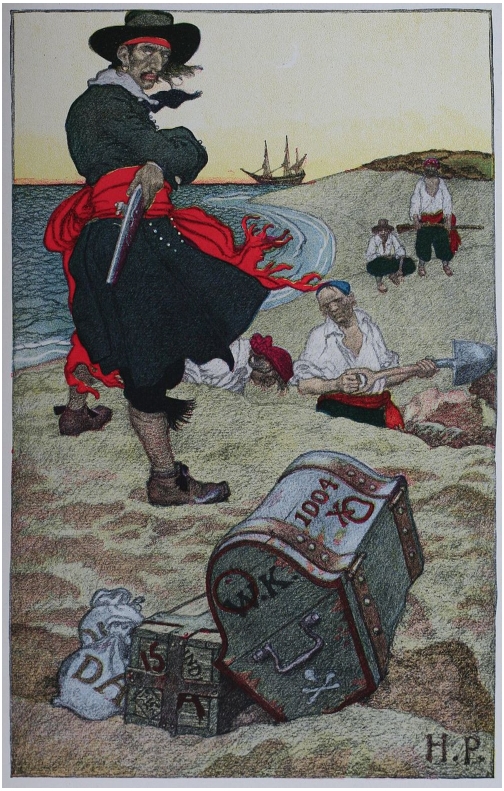
It’s a nice idea, but the historical record doesn’t really support the idea of pirate hoards
However, the notion that Kidd may also have buried treasure somewhere else became very popular in the nineteenth Century, no doubt partly fuelled by popular pirate fiction of the day. This included a persistent rumour that one of Kidd’s surviving crew had told of a cache of treasure buried on a secluded island somewhere east of Boston. However, there is no reason to believe that this has any basis in historical reality and anyway, the idea that a group of pirates would undertake a major civil engineering exercise like that required to create the money pit and its supposed booby traps doesn’t fit with anything we know about them. Buried pirate treasure on Oak Island is a romantic and very appealing theory, but it seems to have no basis in fact.
Although the pirate treasure hoard was a popular theory from the 1860s well into the twentieth Century, it is less accepted now. Part of the problem is the alleged value of the treasure stated by the inscribed stone. Two million pounds in (for example) 1750 would be worth somewhere in the region of 150 million pounds now. So, two million pounds at the time the supposed treasure was buried would represent such a vast amount of money that it’s difficult to see how a pirate, however successful, could have amassed such a sum without this leaving some trace in the historical record.
More recently, other theories have been advanced to suggest that the money pit may contain secret writings by Francis Bacon, the tomb of William Shakespeare, the Ark of the Covenant (buried by the Knights Templar) the menorah from King Solomon’s Temple and treasure buried by the Aztecs. All of these are notable in being unsupported by any hard evidence and generated by supposition, wild leaps of logic and the kind of writing that goes: “If that could be true, then let us suppose that…” And if you expect a refutation of the theory that alien reptilians buried a mind control device on Oak Island thousands of years ago, you’re most likely on the wrong website.

Is William Shakespeare buried on Oak Island? David J. Hansen, Director of The De Vere Foundation first suggested this in 1971, but I haven’t seen a single piece of credible evidence to support this theory.
The only theory that is really worth considering is whether or not the money pit was a man-made structure. If it was, then perhaps something may indeed be buried there? If however, it was a natural sinkhole, then there is no reason to believe that. Part of the problem is that the original money pit no longer exists. The initial shaft has been dug out, re-filled and re-excavated so many times and so many additional shafts have been sunk nearby that we no longer know precisely where the original pit was. All we have are accounts from the late 18th and early 19th Centuries about the finding of the block and tackle, the presence of pick marks inside the shaft of the money pit and the oak platforms placed at every ten feet, all of which strongly suggest a man-made shaft. But we have to remember that there is no contemporary record of any of this. All these accounts come from companies and associations from 1860 onwards which were trying to raise money to excavate the money pit as commercial ventures. All of these groups had a vested interest in proving that the money pit was man-made and we should be very cautious about accepting what they say uncritically.
To take one small example, the 1896 Prospectus for the Oak Island Treasure Company (that was the one that first provided a translation of the inscribed stone) noted that “thousands of people” had seen the inscribed stone while it was mounted in John Smith’s fireplace in his cottage on Oak Island in the period following its discovery in 1803. This simply cannot be true. If thousands of people had visited a small island off a sparsely inhabited part of Nova Scotia to look at this stone, there would be some trace of this in the historical record, either in the form of newspaper articles or mentions in journals, dairies or letters. Diligent research has failed to turn up anything to support this idea. The prospectus also claimed that it was proven that at the base of the money pit were chests containing precious metals and jewels, something that was also completely untrue. If these are lies, as they appear to be, how much credence can we place in other information from this document? And should we believe accounts which originate from other companies attempting to raise money which seem to prove that the pit was man-made? These claims were all made by people trying to raise money to excavate the pit and none are supported by contemporary records.
Set against this, we have the 1867 letter from John Brown, one of the last treasure seekers to actually be able to examine the original money pit. He explicitly stated that he believed that the money pit was a natural formation with a bed of gravel at its base and not a man-made shaft containing treasure. He was also certain that the tunnels connecting the money pit to the sea were also natural formations and not man-made.

Hunting for buried treasure has a huge, elemental and romantic appeal. Who wouldn’t want to dig for a hidden pirate hoard? And that, I think, is really the basis of the Oak Island Mystery. People want to believe in buried treasure, even when that requires a suspension of their normal critical and sceptical faculties.
The story of the exploration of Oak Island from 1795 – 1860 comes to us from people who needed to convince potential investors of the possibility that something of value was buried there. That should make us suspicious. When you add this to the internal inconsistencies in the story of the early digging and the lack of any contemporary records from before 1849, that should make us very doubtful indeed.
Apart from unsupported stories, there was only ever one piece of hard evidence – the inscribed stone said to have been recovered at the ninety foot level in 1803. A stone claimed to have come from Oak Island certainly existed and was on public display until around 1912. After that, no-one knows what happened to it. Which is more than a little odd for an artifact associated with the Oak Island money pit which had already attracted the interest of at least five major expeditions by the time the stone disappeared. With so much treasure claimed to be hidden on the island and the stone being directly associated with that treasure, you would imagine someone would have thought it worth keeping?
And what of the inscription on the stone? The first alleged interpretation of that inscription was included in the 1896 Prospectus for the Oak Island Treasure Company, a document which we have already seen included supposition and outright fabrication masquerading as fact. The inscription was said to read:
“Ten feet below are two million pounds buried.”
Then, in 1949 came Edward Rowe Snow’s book True Tales of Buried Treasure which told us that the inscription actually read:
“Forty feet below two million pounds are buried.”
And of course Snow’s book also gave us for the first time a handwritten copy of the actual inscription itself. Which turned out to be a surprisingly easy to solve substitution code. One of the problems here is that the code is so simple to solve – It’s hard to imagine that no-one had been able to find a solution before 1896 given that the stone had been on public display for some time. And if we accept that the symbols that Snow shows in his book are correct, there is simply no way that the first word can ever have been interpreted as “Ten”. Was the expert who first deciphered the inscription in 1896 looking at a different set of symbols?
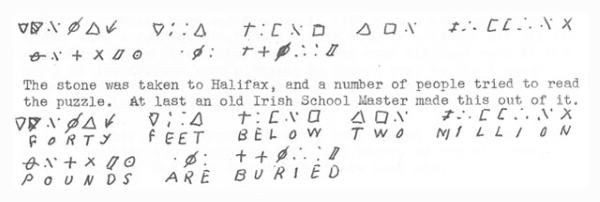
The claimed Oak Island symbols from the inscribed stone and their interpretation, from True Tales of Buried Treasure
But we should be very careful of any interpretation of the symbols themselves (and I’m afraid that whole theories have been based on nothing else). Snow was given the symbols by Reverend Kempton who had himself been given them “over forty years ago” (i.e. before 1909 but presumably after the first publication of the meaning of the inscription in 1896) by a local minister who had got them from an un-named schoolteacher who claimed that the original deciphering was done by a “very bright Irish teacher”. All these people were conveniently dead by the time that Snow’s book was published and this isn’t the sort of provenance that we should be confident about. I think there are grave doubts that the symbols in Snow’s book were actually copied from the inscribed stone and there is no proof whatever that they were. And of course the claimed interpretation of the inscription on the stone is only acceptable to those who believe in buried pirate treasure: otherwise we would expect the stone to have provided a witty epigram from Francis Bacon or instructions on how to operate an alien mind control device.
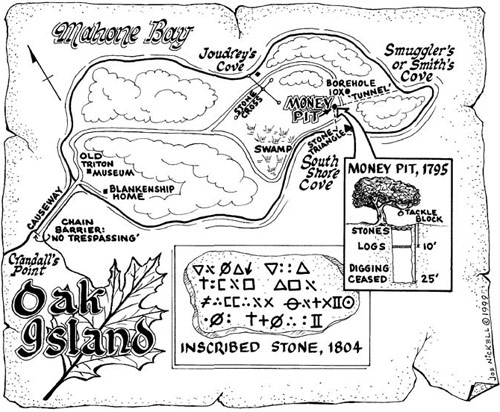
Map produced by Joe Nickel in 1999
It’s also notable that many recent attempts to re-interpret the inscription on the stone are based on a map produced by Oak Island researcher Joe Nickell in 1999 for an article in the Sceptical Enquirer. This included an illustration of the stone with the inscription spread over four lines rather than the two shown in Snow’s book. This is similar to an earlier “artists impression” of the inscribed stone produced by Graham Metson for a tourist map of Oak Island in 1979.
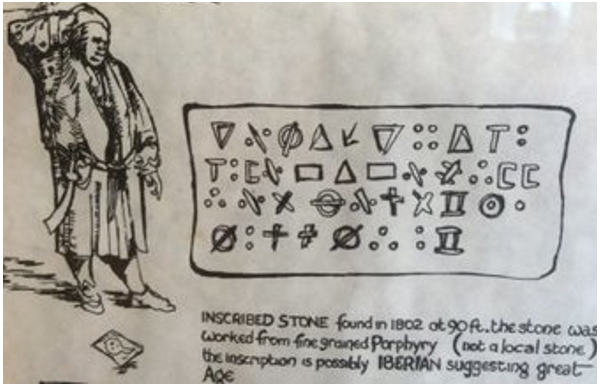
Detail from 1979 Oak Island tourist map drawn by Graham Metson and including an artist’s impression of what the inscribed stone may have looked like.
As far as I am aware, Nickell never claimed that his version of the inscriptions was intended to be an accurate rendering of how the markings were set out on the original stone (because there is no record of this), it is simply a piece of artistic licence utilising most of the symbols from Snow’s book set out to produce an attractive image and in a more logical way than in the 1979 version. Yet, somehow, this has become accepted as an accurate reproduction of the original inscription and a version of this image (often with the text revised to read “1803” instead of “1804”) has been used to “prove” some fairly whacky theories.
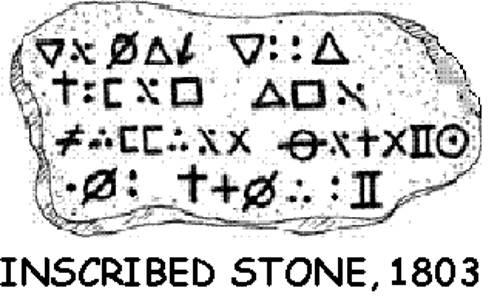
Below you will find an excerpt from an episode of The Curse of Oak Island where an interpretation of the 1999 Nickell drawing of the stone (which is described as “the best description of the stone from the archives”, whatever that means) is used to support the notion that whatever is buried in the money pit has a connection with King Solomon. Or something like that – I’m afraid I lost interest fairly early on. As we have no idea what the original inscribed stone looked like, this whole discussion is fallacious.
The inscribed stone and its purported deciphering are the only main pieces of hard evidence that support the something of value is buried on Oak Island and the provenance of both have a number of problems. No-one has discovered any other evidence to support the idea that the island has ever contained a large, man-made shaft. There is evidence of some form of wooden construction in Smith’s Cove, but we have no idea what this was for. Traces of non-indigenous coconut husks have also been found on Oak Island, but these were commonly used for filtration and packing on ships in the 18th Century and may have been discarded there during the building of the wooden structure.
There are no traces of any man-made booby traps protecting any shaft on Oak Island. The flooding in vertical shafts is explained because the island, like many limestone islands, is honeycombed with subterranean channels through which seawater moves. If you dig down deep enough to connect with one of these, the water will rise to sea level. Some people have even suggested that the deaths of Bob Restall and three others in 1965 were caused by a mysterious gas released by a booby trap. However, it seems much more likely that this was due to an accumulation of Carbon Monoxide or other exhaust products from a nearby petrol driven pump accumulating in the shaft. Tragically, the men were overcome by gas, became unconscious and then drowned in the few feet of water in the bottom of the shaft.
If we discount the stories of the block and tackle, the regularly spaced oak platforms, the booby traps and the inscription on the stone (and there seem to be good reasons for doubting all these things) then what we are left with is a large hole in the ground. There are many sinkholes in and around Oak Island and my best guess is that the original money pit was once such a sinkhole. Over a long period branches from the many oak trees on the island, silt and other floating debris washed into this hole during storms until it was filled. Excavating this could have produced layers of timber and other debris which might then or later have been interpreted as man-made platforms by those predisposed to see this as a hiding place for pirate treasure.
Alternatively, you may choose to believe that Oak Island is the location of a fabulous but unspecified treasure buried there by technically brilliant but strangely stupid (because they left the block and tackle behind! ) pirates. Or Aztecs. Or Reptilians. Or, just possibly, Reptilian Aztec pirates (let’s cover all the bases here). That’s your choice. Personally, I tend towards the hole in the ground theory.
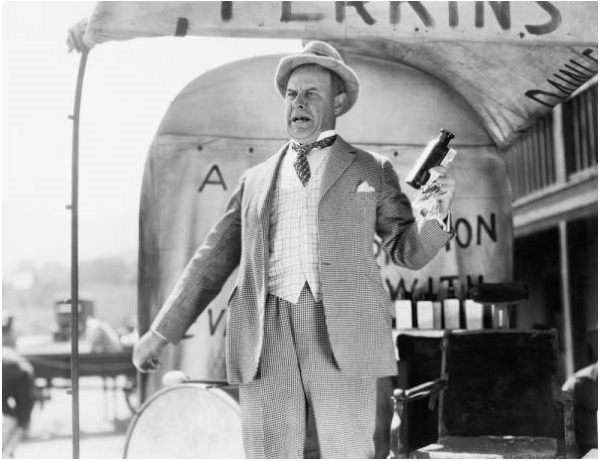
The whole notion of Oak Island as a repository for buried treasure can be traced back to a mid-19th Century boondoggle designed to part naive investors from their money. This was so successful that it is still persuading people to part with their money over one hundred and fifty years later. The very fact that people are still willing to take this nonsense seriously is a testament to the enduring power of imagination over reality and a willingness to believe the hyperbole of slick salesmen over rather more prosaic historic reality.
There are very good reasons to doubt the veracity of the original story of Oak Island as told in 1860 and yet people have subsequently managed to build a whole edifice of belief on top of these wobbly foundations. I don’t believe that there is anything buried on Oak Island other than a great many hopes and dreams. Sorry, but if there is a mystery here at all, it is only that so many people can be so credulous over such a long period.

The Oak Island Compendium – web site providing a great deal of information on Oak Island and the various theories on what may be buried there.
Oak Island – Critical Enquiry Website by researcher Richard Joltes, highly recommended for anyone interested in an objective look at the history of this mystery.
True Tales of Buried Treasure, By Edward Rowe Snow, 1949, Copies of Edward Snow’s book which includes the symbols from the inscribed stone still occasionally turn up both in the original 1949 version and this 1950 reprint.
The Curse of Oak Island – Website for the History Channel television show about Oak Island.
